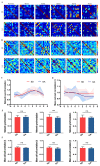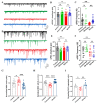Gallic Acid Ameliorates Cognitive Impairment Caused by Sleep Deprivation through Antioxidant Effect
- PMID: 37749929
- PMCID: PMC10569142
- DOI: 10.5607/en23015
Gallic Acid Ameliorates Cognitive Impairment Caused by Sleep Deprivation through Antioxidant Effect
Abstract
Sleep deprivation (SD) has a profound impact on the central nervous system, resulting in an array of mood disorders, including depression and anxiety. Despite this, the dynamic alterations in neuronal activity during sleep deprivation have not been extensively investigated. While some researchers propose that sleep deprivation diminishes neuronal activity, thereby leading to depression. Others argue that short-term sleep deprivation enhances neuronal activity and dendritic spine density, potentially yielding antidepressant effects. In this study, a two-photon microscope was utilized to examine the calcium transients of anterior cingulate cortex (ACC) neurons in awake SD mice in vivo at 24-hour intervals. It was observed that SD reduced the frequency and amplitude of Ca2+ transients while increasing the proportions of inactive neurons. Following the cessation of sleep deprivation, neuronal calcium transients demonstrated a gradual recovery. Moreover, whole-cell patch-clamp recordings revealed a significant decrease in the frequency of spontaneous excitatory post-synaptic current (sEPSC) after SD. The investigation also assessed several oxidative stress parameters, finding that sleep deprivation substantially elevated the level of malondialdehyde (MDA), while simultaneously decreasing the expression of Nuclear Factor erythroid 2-Related Factor 2 (Nrf2) and activities of Superoxide dismutase (SOD) in the ACC. Importantly, the administration of gallic acid (GA) notably mitigated the decline of calcium transients in ACC neurons. GA was also shown to alleviate oxidative stress in the brain and improve cognitive impairment caused by sleep deprivation. These findings indicate that the calcium transients of ACC neurons experience a continuous decline during sleep deprivation, a process that is reversible. GA may serve as a potential candidate agent for the prevention and treatment of cognitive impairment induced by sleep deprivation.
Keywords: ACC; Gallic acid; Oxidative stress; Sleep deprivation.
Conflict of interest statement
The authors declare that they have no competing interests.
Figures






Similar articles
-
Melatonin ameliorates cognitive impairment induced by sleep deprivation in rats: role of oxidative stress, BDNF and CaMKII.Behav Brain Res. 2013 Nov 1;256:72-81. doi: 10.1016/j.bbr.2013.07.051. Epub 2013 Aug 6. Behav Brain Res. 2013. PMID: 23933144
-
Ginsenoside Rh2 reverses sleep deprivation-induced cognitive deficit in mice.Behav Brain Res. 2018 Sep 3;349:109-115. doi: 10.1016/j.bbr.2018.03.005. Epub 2018 Mar 12. Behav Brain Res. 2018. PMID: 29544964
-
Ellagic acid protects mice against sleep deprivation-induced memory impairment and anxiety by inhibiting TLR4 and activating Nrf2.Aging (Albany NY). 2020 May 20;12(11):10457-10472. doi: 10.18632/aging.103270. Epub 2020 May 20. Aging (Albany NY). 2020. PMID: 32433038 Free PMC article.
-
The effects of glucagon-like peptide 1 receptor agonist (exenatide) on memory impairment, and anxiety- and depression-like behavior induced by REM sleep deprivation.Brain Res Bull. 2021 Sep;174:194-202. doi: 10.1016/j.brainresbull.2021.06.011. Epub 2021 Jun 17. Brain Res Bull. 2021. PMID: 34146656
-
Sleep Deprivation-Induced Oxidative Stress in Rat Models: A Scoping Systematic Review.Antioxidants (Basel). 2023 Aug 11;12(8):1600. doi: 10.3390/antiox12081600. Antioxidants (Basel). 2023. PMID: 37627596 Free PMC article.
Cited by
-
Gallic acid alleviates omeprazole-induced depressive behavior and memory impairment.Naunyn Schmiedebergs Arch Pharmacol. 2025 Aug;398(8):10317-10335. doi: 10.1007/s00210-025-03812-w. Epub 2025 Feb 20. Naunyn Schmiedebergs Arch Pharmacol. 2025. PMID: 39976720 Free PMC article.
-
The interaction between sleep patterns and oxidative balance scores on the risk of cognitive function decline: Results from the national health and nutrition examination survey 2011-2014.PLoS One. 2024 Dec 27;19(12):e0313784. doi: 10.1371/journal.pone.0313784. eCollection 2024. PLoS One. 2024. PMID: 39729482 Free PMC article.
-
Suk-SaiYasna Remedy, a Traditional Thai Medicine, Mitigates Stress-Induced Cognitive Impairment via Keap1-Nrf2 Pathway.Int J Mol Sci. 2025 Jun 4;26(11):5388. doi: 10.3390/ijms26115388. Int J Mol Sci. 2025. PMID: 40508195 Free PMC article.
References
LinkOut - more resources
Full Text Sources
Miscellaneous

